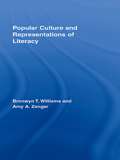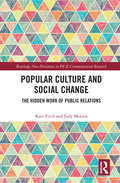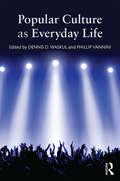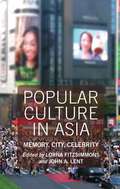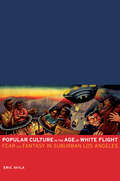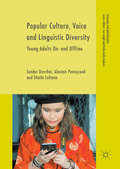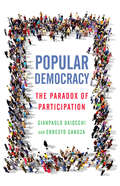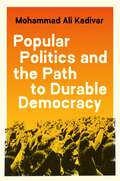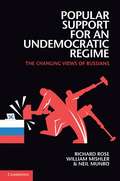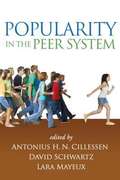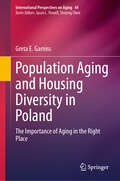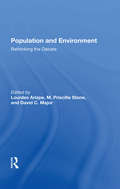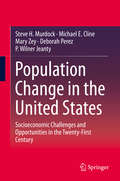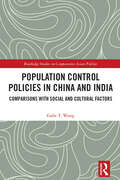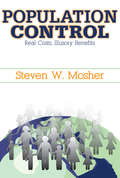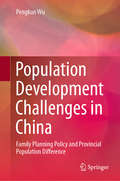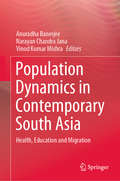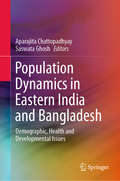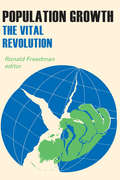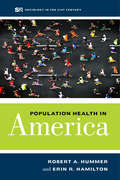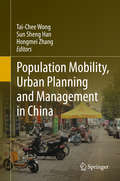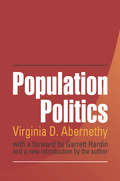- Table View
- List View
Popular Culture and Representations of Literacy (Routledge Research in Literacy)
by Bronwyn Williams Amy ZengerMovies are filled with scenes of people of all ages, sexes, races, and social classes reading and writing in widely varied contexts and purposes. Yet these scenes go largely unnoticed, despite the fact that these images recreate and reinforce pervasive concepts and perceptions of literacy. This book addresses how everyday literacy practices are represented in popular culture, specifically in mainstream, widely-distributed contemporary movies. If we watch films carefully for who reads and writes, in what settings, and for what social goals, we can see a reflection of the dominant functions and perceptions that shape our conceptions of literacy in our culture. Such perceptions influence public and political debates about literacy instruction, teachers' expectations of what will happen in their classrooms, and student's ideas about what reading and writing should be.
Popular Culture and Social Change: The Hidden Work of Public Relations (Routledge New Directions In Public Relations & Communication Ser.)
by Judy Motion Kate FitchPopular Culture and Social Change: The Hidden Work of Public Relations argues the complicated and contradictory relationship between public relations, popular culture and social change is a neglected theoretical project. Its diverse chapters identify ways in which public relations influences the production of popular culture and how alternative, often community-driven conceptualisations of public relations work can be harnessed for social change and in pursuit of social justice. This book opens up critical scholarship on public relations in that it moves beyond corporate understandings and perspectives to explore alternative and eclectic communicative cultures, in part to consider a more optimistic conceptualisation of public relations as a resource for progressive social change. Fitch and Motion began with an interest in identifying the ways in which public relations both draws on and influences the production of popular culture by creating, promoting and amplifying particular narratives and images. The chapters in this book consider how public relations creates popular cultures that are deeply compromised and commercialised, but at the same time can be harnessed to advocate for social change in supporting, reproducing, challenging or resisting the status quo. Drawing on critical and sociocultural perspectives, this book is an important resource for researchers, educators and students exploring public relations theory, strategic communication and promotional culture. It investigates the entanglement of public relations, popular culture and social change in different social, cultural and political contexts – from fashion and fortune telling to race activism and aesthetic labour – in order to better understand the (often subterranean) societal influence of public relations activity.
Popular Culture as Everyday Life
by Phillip Vannini Dennis D. WaskulIn Popular Culture and Everyday Life Phillip Vannini and Dennis Waskul have brought together a variety of short essays that illustrate the many ways that popular culture intersects with mundane experiences of everyday life. Most essays are written in a reflexive ethnographic style, primarily through observation and personal narrative, to convey insights at an intimate level that will resonate with most readers. Some of the topics are so mundane they are legitimately universal (sleeping, getting dressed, going to the bathroom, etc.), others are common enough that most readers will directly identify in some way (watching television, using mobile phones, playing video games, etc.), while some topics will appeal more-or-less depending on a reader's gender, interests, and recreational pastimes (putting on makeup, watching the Super Bowl, homemaking, etc.). This book will remind readers of their own similar experiences, provide opportunities to reflect upon them in new ways, as well as compare and contrast how experiences relayed in these pages relate to lived experiences. The essays will easily translate into rich and lively classroom discussions that shed new light on a familiar, taken-for-granted everyday life--both individually and collectively. At the beginning of the book, the authors have provided a grid that shows the topics and themes that each article touches on. This book is for popular culture classes, and will also be an asset in courses on the sociology of everyday life, ethnography, and social psychology.
Popular Culture in Asia
by Lorna Fitzsimmons John A. LentAsian Popular Culture in Transition examines contemporary consumption practices in South Korea, China, India, and Japan, and both updates and extends popular culture studies of the region. Through an interdisciplinary lens, this collection of essays explores how recent advances and shifts in information technologies and globalization have impacted cultural markets, fashion, the digital generation, mobile culture, femininity, matrimonial advertising, and a film actress' image and performance. Drawing upon a diverse range of sources and methods including historical research, content analysis, anthropological observation, textual analyses, and interviews, Asian Popular Culture in Transition makes a significant contribution to this growing area of research. Given its broad range of countries, theories, and approaches, this book will be of great interest to students and scholars of Asian studies, cultural studies, media and communication studies, and gender studies.
Popular Culture in the Age of White Flight: Fear and Fantasy in Suburban Los Angeles (American Crossroads #13)
by Eric AvilaLos Angeles pulsed with economic vitality and demographic growth in the decades following World War II. This vividly detailed cultural history of L.A. from 1940 to 1970 traces the rise of a new suburban consciousness adopted by a generation of migrants who abandoned older American cities for Southern California's booming urban region. Eric Avila explores expressions of this new "white identity" in popular culture with provocative discussions of Hollywood and film noir, Dodger Stadium, Disneyland, and L.A.'s renowned freeways. These institutions not only mirrored this new culture of suburban whiteness and helped shape it, but also, as Avila argues, reveal the profound relationship between the increasingly fragmented urban landscape of Los Angeles and the rise of a new political outlook that rejected the tenets of New Deal liberalism and anticipated the emergence of the New Right. Avila examines disparate manifestations of popular culture in architecture, art, music, and more to illustrate the unfolding urban dynamics of postwar Los Angeles. He also synthesizes important currents of new research in urban history, cultural studies, and critical race theory, weaving a textured narrative about the interplay of space, cultural representation, and identity amid the westward shift of capital and culture in postwar America.
Popular Culture, Voice and Linguistic Diversity
by Alastair Pennycook Sender Dovchin Shaila SultanaThis book analyses the language practices of young adults in Mongolia and Bangladesh in online and offline environments. Focusing on the diverse linguistic and cultural resources these young people draw on in their interactions, the authors draw attention to the creative and innovative nature of their transglossic practices. Situated on the Asian periphery, these young adults roam widely in their use of popular culture, media voices and linguistic resources. This innovative and topical book will appeal to students and scholars of sociolinguistics, applied linguistics, cultural studies and linguistic anthropology.
Popular Democracy: The Paradox of Participation
by Gianpaolo Baiocchi Ernesto GanuzaLocal participation is the new democratic imperative. In the United States, three-fourths of all cities have developed opportunities for citizen involvement in strategic planning. The World Bank has invested $85 billion over the last decade to support community participation worldwide. But even as these opportunities have become more popular, many contend that they have also become less connected to actual centers of power and the jurisdictions where issues relevant to communities are decided. With this book, Gianpaolo Baiocchi and Ernesto Ganuza consider the opportunities and challenges of democratic participation. Examining how one mechanism of participation has traveled the world--with its inception in Porto Alegre, Brazil, and spread to Europe and North America--they show how participatory instruments have become more focused on the formation of public opinion and are far less attentive to, or able to influence, actual reform. Though the current impact and benefit of participatory forms of government is far more ambiguous than its advocates would suggest, Popular Democracy concludes with suggestions of how participation could better achieve its political ideals.
Popular Music Scenes: Regional and Rural Perspectives (Pop Music, Culture and Identity)
by Ben Green Andy Bennett Natalie Lewandowski David CashmanThis book examines regional and rural popular music scenes in Europe, Asia, North America and Australia. The book is divided into four parts. Part 1 will focus on the spatial aspects of regional popular music scenes and how place and locality inform the perceptions and discourses of those involved in such scenes. Part 2 focuses on the technologies and forms of distribution whereby regional and rural popular music scenes exist and, in many cases co-exist in forms of trans-local connection with other scenes. Part 3 considers the importance of collective memory in the way that regional and rural popular music scenes are constructed in both the past and the present. Part 4 examines themes of industry and policy, in relation to culture and music, as these impact on the nature and identity of rural and regional popular music scenes.
Popular Politics and the Path to Durable Democracy (Princeton Studies In Global And Comparative Sociology Ser.)
by Mohammad Ali KadivarA groundbreaking account of how prolonged grassroots mobilization lays the foundations for durable democratizationWhen protests swept through the Middle East at the height of the Arab Spring, the world appeared to be on the verge of a wave of democratization. Yet with the failure of many of these uprisings, it has become clearer than ever that the path to democracy is strewn with obstacles. Mohammad Ali Kadivar examines the conditions leading to the success or failure of democratization, shedding vital new light on how prodemocracy mobilization affects the fate of new democracies.Drawing on a wealth of new evidence, Kadivar shows how the longest episodes of prodemocracy protest give rise to the most durable new democracies. He analyzes more than one hundred democratic transitions in eighty countries between 1950 and 2010, showing how more robust democracies emerge from lengthier periods of unarmed mobilization. Kadivar then analyzes five case studies—South Africa, Poland, Pakistan, Egypt, and Tunisia—to investigate the underlying mechanisms. He finds that organization building during the years of struggle develops the leadership needed for lasting democratization and strengthens civil society after dictatorship.Popular Politics and the Path to Durable Democracy challenges the prevailing wisdom in American foreign policy that democratization can be achieved through military or coercive interventions, revealing how lasting change arises from sustained, nonviolent grassroots mobilization.
Popular Protest in Late Medieval English Towns
by Samuel K. Cohn Jr.Contrary to received opinion, revolts and popular protests in medieval English towns were as frequent and as sophisticated, if not more so, as those in the countryside. This groundbreaking study refocuses attention on the varied nature of popular movements in towns from Carlisle to Dover and from the London tax revolt of Longbeard in 1196 to Jack Cade's Rebellion in 1450, exploring the leadership, social composition, organisation and motives of popular rebels. The book charts patterns of urban revolt in times of strong and weak kingship, contrasting them with the broad sweep of ecological and economic change that inspired revolts on the continent. Samuel Cohn demonstrates that the timing and character of popular revolt in England differed radically from revolts in Italy, France and Flanders. In addition, he analyses repression and waves of hate against Jews, foreigners and heretics, opening new vistas in the comparative history of late medieval Europe.
Popular Religion in Russia: 'Double Belief' and the Making of an Academic Myth (Routledge Studies in the History of Russia and Eastern Europe #Vol. 10)
by Stella RockThis book dispels the widely-held view that paganism survived in Russia alongside Orthodox Christianity, demonstrating that 'double belief', dvoeverie, is in fact an academic myth. Scholars, citing the medieval origins of the term, have often portrayed Russian Christianity as uniquely muddied by paganism, with 'double-believing' Christians consciously or unconsciously preserving pagan traditions even into the twentieth century. This volume shows how the concept of dvoeverie arose with nineteenth-century scholars obsessed with the Russian 'folk' and was perpetuated as a propaganda tool in the Soviet period, colouring our perception of both popular faith in Russian and medieval Russian culture for over a century. It surveys the wide variety of uses of the term from the eleventh to the seventeenth century, and contrasts them to its use in modern historiography, concluding that our modern interpretation of dvoeverie would not have been recognized by medieval clerics, and that 'double-belief' is a modern academic construct. Furthermore, it offers a brief foray into medieval Orthodoxy via the mind of the believer, through the language and literature of the period.
Popular Support for an Undemocratic Regime
by Neil Munro Richard Rose William MishlerTo survive, all forms of government require popular support, whether voluntary or involuntary. Following the collapse of the Soviet system, Russia's rulers took steps toward democracy, yet under Vladimir Putin Russia has become increasingly undemocratic. This book uses a unique source of evidence, eighteen surveys of Russian public opinion from the first month of the new regime in 1992 up to 2009, to track the changing views of Russians. Clearly presented and sophisticated figures and tables show how political support has increased because of a sense of resignation that is even stronger than the unstable benefits of exporting oil and gas. Whilst comparative analyses of surveys on other continents show that Russia's elite is not alone in being able to mobilize popular support for an undemocratic regime, Russia provides an outstanding caution that popular support can grow when governors reject democracy and create an undemocratic regime.
Popularity in the Peer System
by David Schwartz Antonius CillessenBringing together leading researchers, this is the first volume to comprehensively examine popularity among children and adolescents what it is, how it is attained, and its impact on peer interaction and individual development. The book clarifies how popularity is distinct from being socially accepted or well liked and how it is different for girls and boys. Behaviors that characterize popular peers are explored, as are the developmental benefits and risks of popularity and its connections to peer influence processes. Innovative measurement approaches and research designs are clearly described.
Population Aging and Housing Diversity in Poland: The Importance of Aging in the Right Place (International Perspectives on Aging #44)
by Greta E. GarnissThis book provides new and original insight on the senior living housing needs in Poland. It focuses on housing needs of the 60-74 age group that are generally more mobile and not in need of services offered in care homes. The book not only shows that seniors prefer to live independently as long as possible, but also touches upon their primary conditions for this, such as properties near goods, services and social networks, in modern buildings that have common amenities that meet their needs as they age. The book also discusses the transformation of economic, social and cultural changes leading to the creation of a new housing options for younger seniors living in many cities in Poland. With the book concluding that there is need for more diverse housing choice for senior living than is currently available, it provides an interesting read for academics, professionals and local, regional and national social service agencies that work with seniors.
Population And Environment: Rethinking The Debate
by Lourdes Arizpe David Major M. Priscilla Stone Priscilla StoneThis ambitious interdisciplinary volume places population processes in their social, political, and economic contexts while it considers their environmental impacts. Examining the multi-faceted patterns of human relationships that overlay, alter, and distort our ties to urban and rural landscapes, the book focuses especially on the essential experi
Population Change in the United States
by Steve H. Murdock Michael E. Cline Mary Zey Deborah Perez P. Wilner JeantyThis new volume maps the complex interplay of demographic and socioeconomic changes in the United States, where rapid aging and ethnic diversification are merely the most salient of the many issues with major long-term implications. Drawing on The United States Census Bureau's post-2010 detailed projections, as well as a wealth of data distilled from authoritative sources, the authors tackle many of the urgent policy questions raised by America's changing population. The book explores the ways economic markets are adapting to an older and more diverse customer base, how the projected demographic change will impact public service demand, the growing economic disparities between asset-rich baby boomers and youth struggling for economic security, and how the projected demographic patterns will change the fiscal, economic, education, health, and housing sectors and alter the social structures and processes impacting American households and the diverse array of America's future population. A thorough survey of major demographic patterns in the USA up to 2050 is followed by an assessment of how these will affect socioeconomic, public service, fiscal, economic, and social structures and mechanisms, down to the size and composition of households. The analysis then considers possible variations of outcome predicated on alternative dynamic patterns between demographics and socioeconomics. Cutting through the politics and communal anxieties with hard, cutting-edge data, this study will be a primary source for all those who must use its contents to guide their decisions.
Population Control Policies in China and India: Comparisons with Social and Cultural Factors (Routledge Studies on Comparative Asian Politics)
by Gabe T. WangThis book comprehensively compares the development of population control policies in China and India, their implementations, and the population changes over the past seven decades. Analyzing how populations have changed and affected socioeconomic development in the two societies, this book systematically compares China and India through social and cultural factors, including religion and traditional perspectives on population, ethnicity and language, social classes, family, social status and education of women, and government functions. A brief introduction discusses how China has developed into a highly homogenous society and how India has developed into a highly diversified nation in history, and the influence of other countries on these two societies. With empirical data, the book analyzes how population changes are strongly correlated with economic development in the two most populous societies. An insightful discussion of the population issues with a world perspective and historical understanding of China and India is also provided. This book will be valuable reading to students and researchers interested in knowing more about the population control policies, population changes, and cultures and societies in China and India.
Population Control: Real Costs, Illusory Benefits
by Steven W. MosherFor over half a century, policymakers committed to population control have perpetrated a gigantic, costly, and inhumane fraud upon the human race. They have robbed people of the developing countries of their progeny and the people of the developed world of their pocketbooks. Determined to stop population growth at all costs, those Mosher calls "population controllers" have abused women, targeted racial and religious minorities, undermined primary health care programs, and encouraged dictatorial actions if not dictatorship. They have skewed the foreign aid programs of the United States and other developed countries in an anti-natal direction, corrupted dozens of well-intentioned nongovernmental organizations, and impoverished authentic development programs. Blinded by zealotry, they have even embraced the most brutal birth control campaign in history: China's infamous one-child policy, with all its attendant horrors. There is no workable demographic definition of "overpopulation." Those who argue for its premises conjure up images of poverty - low incomes, poor health, unemployment, malnutrition, overcrowded housing to justify anti-natal programs. The irony is that such policies have in many ways caused what they predicted - a world which is poorer materially, less diverse culturally, less advanced economically, and plagued by disease. The population controllers have not only studiously ignored mounting evidence of their multiple failures; they have avoided the biggest story of them all. Fertility rates are in free fall around the globe. Movements with billions of dollars at their disposal, not to mention thousands of paid advocates, do not go quietly to their graves. Moreover, many in the movement are not content to merely achieve zero population growth, they want to see negative population numbers. In their view, our current population should be reduced to one or two billion or so. Such a goal would keep these interest groups fully employed. It would also have dangerous consequences for a global environment.
Population Development Challenges in China: Family Planning Policy and Provincial Population Difference
by Pengkun WuThis book explores the population development challenges in China. It started by analyzing two of the major challenges: designing a suitable family planning policy and dealing with the serious provincial population difference. It then proposes effective measures to address these challenges by adopting various quantitative methods, such as system dynamics, nonlinear programming and spatial econometrics in evaluating the effects of different policy scenarios, which made the results more scientific and reliable, thus the final policy suggestions effective and evidence based. The book includes a number of mathematical models and is suitable for graduate students and researchers in population modeling and relevant research areas.
Population Dynamics in Contemporary South Asia: Health, Education and Migration
by Anuradha Banerjee Vinod Kumar Mishra Narayan Chandra JanaThis book discusses the sequential development of population research in India, focusing on contemporary issues like demography, population studies, geography, sociology, urban studies and many more. It describes the problems related to the underdeveloped regions in India, Nepal and Bangladesh and includes tabular representations of the analyzed data as well as visual representations/illustrations in the form of graphs and maps. Further, it features fascinating case studies on primary field-research experiences. Presenting interdisciplinary contributions, the book is divided into four sections: the first part examines social issues related to health, while the second explores social sustainability, lifestyles, and cultural aspects. The third and fourth sections address migration and quality of life, respectively. The book is of interest to students studying demography, as well as researchers and policymakers in the fields of population studies, geography and sociology.
Population Dynamics in Eastern India and Bangladesh: Demographic, Health and Developmental Issues
by Aparajita Chattopadhyay Saswata GhoshThis book highlights historical and current perspectives on population issues in the Bengali-speaking states of India (i.e., West Bengal, Tripura, Assam) and Bangladesh and explores three core population dynamics: fertility, mortality–morbidity and development. Furthermore, it presents a selection of revealing cases from area-specific micro-studies, mainly conducted in West Bengal and Bangladesh. The book covers various demographic and health issues in these two regions, which are similar in terms of several sociocultural aspects, yet dissimilar in terms of their policies and programs. Adopting an integrated approach that combines various disciplines and perspectives, it explores highly topical issues such as social inequality, religious difference and mental health. The book is intended for a broad readership interested in population studies, sociology and development, including academics, researchers, planners and policymakers.
Population Growth: The Vital Revolution
by Ronald FreedmanThe population of the modern world continues to grow at a rate unprecedented in human history. How are we to explain this massive increase in the number of living people? What is its consequence, now and for the future? How have populations changed in size and structure since the advent of industrial technology? Can we predict the population trends in developing countries? These and many other significant questions are dealt with in a persuasive yet accessible manner in Ronald Freedman's pivotal "Population Growth".Modern population trends are unique in historical perspective; describing them as part of a "vital revolution" is not an exaggeration. The more popular term "population explosion" is less accurate because it refers to only one aspect of the current situation - the unprecedented growth rates. In the last two centuries other important trends have developed, also without precedent in all of the previous millennia of human history. While the size of population growth is very important in itself, the essays in this volume demonstrate that many other aspects of structure and change in populations are equally important.In readable, non-technical language, these collected essays analyze the most important modern trends in world population. The essays include comprehensive discussions of population theory, analyses of population trends, and prospects in the United States and surveys of population trends in other major areas of the world. As a survey of current population problems, this book will be a library staple for those involved in international development programs, sociologists, family planning workers, and everyone concerned with the contemporary vital revolution in population.
Population Health in America (Sociology in the Twenty-First Century #5)
by Robert A. Hummer Erin R. HamiltonIn this engaging and accessibly written book, Population Health in America weaves demographic data with social theory and research to help students understand health patterns and trends in the U.S. population. While life expectancy was estimated to be just 37 years in the United States in 1870, today it is more than twice as long, at over 78 years. Yet today, life expectancy in the U.S. lags behind almost all other wealthy countries. Within the U.S., there are substantial social inequalities in health and mortality: women live longer but less healthier lives than men; African Americans and Native Americans live far shorter lives than Asian Americans and White Americans; and socioeconomic inequalities in health have been widening over the past 20 years. What accounts for these population health patterns and trends? Inviting students to delve into population health trends and disparities, demographers Robert Hummer and Erin Hamilton provide an easily understandable historical and contemporary portrait of U.S. population health. Perfect for courses such as population health, medical or health sociology, social epidemiology, health disparities, demography, and others, as well as for academic researchers and lay persons interested in better understanding the overall health of the country, Population Health in America also challenges students, academics, and the public to understand current health policy priorities and to ask whether considerably different directions are needed.
Population Mobility, Urban Planning and Management in China
by Tai-Chee Wong Sun Sheng Han Hongmei ZhangThis volume contains essays that examine contemporary urban and regional planning and development in China. Through in-depth theoretical and empirical analysis, it provides insights into the urban policies and operational mechanisms of this colossal transitional economy which has presented unprecedented challenges and dynamics. Inside, readers will discover the causes and consequences of rapid urbanization that have led to a series of environmental, economic and social planning and management measures designed to achieve quality urban living. The essays also detail efforts in adopting the latest options in city building such as specific urban planning approaches in developing large city regions, building cities without slums, constructing new townships and green urbanism, including eco-city and sustainable transport. In addition, coverage explores financial management and support as a means to encourage urbanization and urban economic growth in less-developed regions. Overall, the volume offers a wealth of concrete, detailed information on conditions in different regions of China and features an extensive range of content, methods and theory. It provides readers with a comprehensive portrait of the chain relationship between rapid urbanization, spatial planning and management throughout the country. The book will serve as a useful reference for national and international consultancy services doing business or serving public interest in China. It will also be of interest to an international audience seeking a better understanding of urban development and planning in China, including university teachers, students, government agencies and general readers.
Population Politics: The Choices That Shape Our Future
by Virginia Abernethy Garrett HardinInternational efforts to regulate fertility rates so that populations do not grow beyond the earth's capacity have included technical assistance and capital; improved health care conditions to lower the risk of infant mortality; increased opportunities to develop literacy; the democratization of governments; and several decades of liberal immigration and refugee policies favoring third world nations. The persistence of high fertility despite international efforts confounds demographers. 'Population Politics' brilliantly dissects the paradigm responsible for the counterproductive efforts of nations and international agencies. Abernethy, a renowned anthropologist, shows why policies hamper the shift to lower fertility. Ireland, Indonesia, Cuba, China, Turkey and Egypt are but a few of the countries Abernethy examines, showing how economic, sociocultural, and agricultural factors that have caused population growth can be harnessed to stabilize population size. 'Population Politics' is a provocative examination of the influence of aid and liberal immigration policies on world population growth, and often counterproductive to the role of the United States as an industrial power. This volume's uniquely interdisciplinary perspective will enlighten the lay reader, as well as demographers and epidemiologists, conservationists, reproduction and family specialists, agricultural economists, and public health personnel. Virginia D. Abernethy is professor emeritus of psychiatry (anthropology) at Vanderbilt Medical School and was for 11 years the editor of the scholarly journal 'Population and Environment. Garrett Hardin is emeritus professor of human ecology in the Department of Biological Sciences and the University of California, Santa Barbara.
